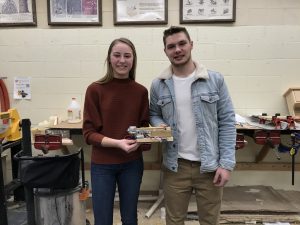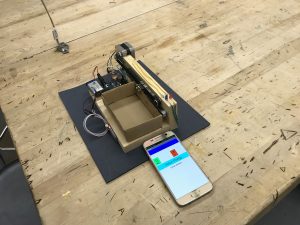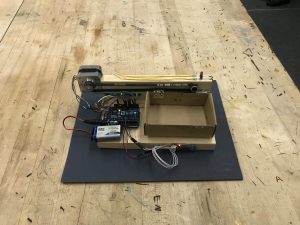The Warren Hills school district aims to lay framework for careers in the skilled trades. By Loren Kessell
As the skilled labor shortage affecting the kitchen and bath design and remodeling industry intensifies, the importance of building a foundation for skilled trades increases.
On a cold Friday this month, the NKBA visited Warren Hills Regional High School in Washington, N.J., to meet with two innovative students already exploring both building and smart-home technology.
The school bustled with students heading to extracurricular activities such as the robotics team. Their project whizzed around in the hallway neighboring the computer science classroom. Daryl Detrick, the school’s computer science teacher, excitedly led a visitor to meet the students who created a voice-activated drawer.

Meet Emily Brundage and Dominic Palazzolla, both seniors in Detrick’s Advanced Topics in Computer Science class. They sat cheerfully and humbly in their seats talking about their interests and what their futures may hold.
Brundage is interested in computer science, art and engineering, and she is considering going to college for industrial engineering. She’s also part of the high school’s Girls Coding With Girls program, which aims to teach middle-school girls how to program. Palazzola plans to attend Rutgers University in New Brunswick, N.J., where he will study computer science. He is part of the high school’s robotics team.
Brundage and Palazzolla initially created an app using the MIT App Inventor for voice activation, but they decided to take it one step further by integrating it with a drawer they built.
“We had already added a voice module to our project,” Palazzolla said. “Our main goal was to get the Bluetooth to work well.”
Brundage added, “We finished this in about eight classes.”
Their voice-activated drawer is controlled via the app, and it reacts to the commands “open drawer” and “close drawer.” It operates via an Arduino, which is essentially a microprocessor the size of a credit card.

“This project is a great starting point,” Brundage said. “The fact we completed this in just a few class periods is amazing, and I can’t imagine what we can do with more time.”
Palazzolla explained the benefits of their project.
“The drawer operating with voice-activated technology is immensely helpful,” Palazzolla said. “This technology could make anything in the kitchen automatic,” potentially beneficial to residents whose dexterity is compromised. Their project combines important elements from the K&B industry, such as building, smart tech and living in place design.
“Smart home technology is constantly growing,” Brundage said. “I love that there’s so much you can do with it.”
Detrick’s computer science class focuses on building a foundation for students, so they can excel at Warren Hills and beyond.
“The skills they’re learning include problem-solving, communication and working with a team,” Detrick said. “These skills will be valuable to them in all fields.”
Have they ever given skilled trades consideration?
“It’s definitely interesting,” Palazzolla said. “My dad is a plumber, and I see what he does every day — I think there is some interest there.”
“I’ll be in the sphere,” Brundage said. “We need people in the field, and skilled trades are so important.”
Warren Hills Regional High School is fostering an environment in which students like Brundage and Palazzolla may thrive. This means implementing pathway programs in collaboration with the NKBA that will offer students a multitude of options for their lives after high school.
“These first steps are critical to developing programs that make students aware of the opportunities in the skilled trades, design and construction, said Bill Darcy, NKBA CEO. “Our NextUp program encourages students to consider these career pathways, and we’re proud to be a part of Warren Hills Regional High School’s innovation. This important program exemplifies our NextUp initiative launching at KBIS, which aims to inspire the next generations of skilled professionals.”

“Our goals for the pathway programs are to inspire, to provide direction and to prepare students for life after Warren Hills,” Chris Kavcak, Warren Hills Regional High School principal, said.
The initial pathways will comprise computer science, manufacturing and design, architecture and construction, engineering and social-media marketing. The goal is to launch them in 2019 or 2020. Detrick and Kavcak hope this will encourage students to actively choose a skilled trade career rather than just falling into a field because they don’t know what else to do.
“We believe that if students can see the opportunities that are before them, they will more easily buy into the education process,” Detrick said. “They will think ‘I want and need to do this.’”
Coming down the pipeline will hopefully be more efficient equipment for manufacturing, such as a Computer Numerical Control (CNC), so students can learn to work with and alter materials like wood and metals. This allows creating more consistent product in applications like kitchen cabinetry.
“The idea behind this is to implement an understanding of materials and then move into integrating that with tech,” Kavcak explained.
These pathways will combine integration of tech with skilled trades, and they will provide direction and knowledge about alternatives to a traditional four-year college or university.
“It’s our job to prepare students with skills that are useful, no matter what the job market looks like,” Kavcak said.
But the innovation is happening in more than just Warren Hills Regional High School. The district extended the reach to its middle school, as well. Jacqueline Solecitto, the teacher for the gifted-and-talented program, now runs the middle school’s MakerSpace.
“Our MakerSpace is a combination of industrial arts, fine arts, tech and arts and crafts,” Solecitto said. “It’s a great creative space for tinkering, brainstorming and using found objects.”
Its purpose is to offer a space for students to work outside the realm of a classroom.
“Within the structure of a standard school day, students don’t always get to use their creativity,” Solecitto said. “All of these ideas now have a venue.”
This space will be beneficial for a current initiative being implemented for this spring at Warren Hills Regional Middle School. It is a contest titled “The Kitchen of the Future Innovation Contest,” and the tagline is “where creativity meets technology.” Entrants must be in seventh or eighth grade at WHRMS, and they may choose to work alone or in a group.
“The idea behind the MakerSpace is to create opportunity for students to create and invent,” Detrick said.
Their projects must include a two-dimensional blueprint or sketch drawn to scale, a functioning prototype, a log or written component that includes their brainstorming and research and a tri-fold board presentation showcasing the design.
Another pilot program for submission is tasking students with creating Lego robots that complete tasks in the kitchen. It would be based on the First Lego League using EV3 Lego robotics.
The NKBA will continue to work with the Warren Hills School District to help launch these programs and build upon that foundation.
“People think college is the best way to go, but college is only one way to go,” Detrick offered. “We need to remove the stigma from skilled labor and show how diverse those opportunities are.”
At KBIS 2019 in February, the NKBA is representing the skilled trades with several initiatives, including Cheers for Trade Careers, supporting the Skilled Labor Fund fundraiser and hosting 150 Las Vegas-area high school students at the show to pique their interests in the skilled trade industry. For more information, visit KBIS.com.








